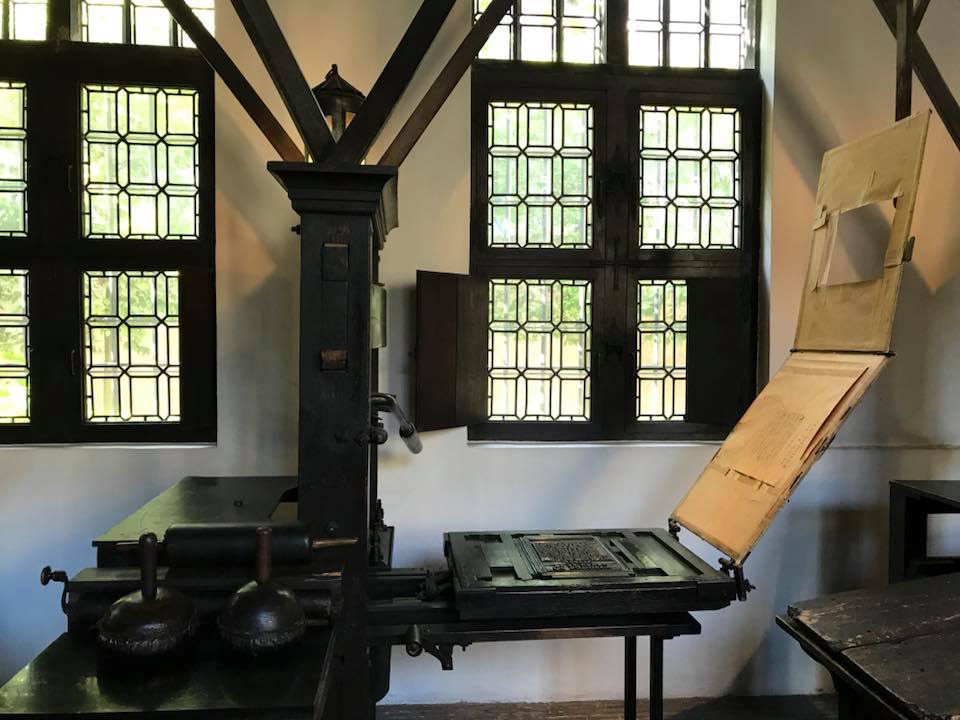The movable-type press is a system of printing and typography that uses movable components to reproduce a document usually on a paper. The figure behind this technology is Johannes Gutenberg, who in mid-15th century Europe, introduced the metal movable-type. Gutenberg created his type pieces (the metallic alphabets, numbers, and punctuation) from lead, tin, and antimony, which were the standard materials for printing for over 550 years.
Gutenberg’s movable-type was quicker than the traditional woodblock printing. This paved the way for the rapid printing of the bible (“Gutenberg Bible”) which eventually placed the movable-type as an important “invention” in the early modern European period. The printing press even assisted Martin Luther in the quick dissemination of the infamous “Ninety-five Theses” or “Disputation on the Power of Indulgences” which shook the authority of the Catholic Church. Eventually, the technology of the press rapidly spread in the European continent. One of the figures who was influenced by Gutenberg’s invention was Christophe Plantin.

Plantin’s printing company was founded in the 16th century. The workshop (printing press) was established in his house in Antwerp, Belgium. During his time, Plantin was considered a major figure in printing, especially since he was constantly printing manuscripts in the humanities. The most popular manuscripts printed by his company were the eight-volume, multi-language Polyglot Bible with Hebrew, Aramaic, Greek and Syriac texts (which are today kept in his mansion/house-turned into a museum).

After Plantin’s death, his son-in-law Jan Moretus inherited the workshop and the mansion. Moretus lived in a period where the “old style” was being challenged by a new method of printing – the offset-type. Nonetheless, Moretus was able to preserve some original prints of the movable-type created by his father-in-law.
Today, the once-upon-a-time workshop house and mansion is now a museum. The 16th century-printing technology and system is still functional. Once in a while, some documents/manuscripts are still being printed through the movable type. Now known as the Plantin-Moretus House-Workshops-Museum Complex, it is a UNESCO World Heritage Site, nominated by City of Antwerp in 2002 and finally inscribed in 2005.
The museum was excellently curated. Entering the first section (“the house”) was a walk back in the early modern era – the decorations, the arrangements of the furniture and the ambiance.
The museum houses a massive and impressive collection of 16th to 19th century printed collections – mostly manuscripts printed by Plantin and Moretus. Some of the important collections in the museum are: the Biblia Polyglotta (printed between 1568 and 1573), Cornelis Kiliaan’s Thesaurus Teutoniae Linguae (the first Dutch Dictionary), Abraham Ortelius’ Theatrum Orbis Terrarum (the first printed atlas), a 16th century book of herbs called Cruydtboeck collated by Rembert Dodoens, an anatomical book by Andreas Vesalius and Joannes Valverde, Simon Stevin’s book of decimal numbers, 36 line Bible, Peter Paul Ruben’s drawings and paintings, and a collection of Justus Lipsius works (most important work printed was his book of history).
For me, there are three memorable sites in this WHS: the library, the workshop (printing house) and the courtyard.

The library is arranged using a 17th-century model. The library is composed of high shelves filled with collections arranged according to size. Notable in the library are the detailed lecterns, globes, and busts. The designs of the wooden busts on the lecterns depict saints and popes. The plaster busts on the shelves depict Greek and Roman scholars and emperors.

The workshop (printing house), according to the website of the complex, is the “heart of the mansion.” It contains the two oldest printing presses in the world, dating from around 1600. The six other presses are still in working order.

The courtyard is a masterpiece. According to the official website of the complex, the courtyard had already turned the complex into a tourist attraction in Plantin’s own time. Kings, princes and prominent figures came to visit. Today, one can see and smell popular plants from the 16th and 17th centuries. Nonetheless, the current landscape of the courtyard was constructed only in 1992 modeled after a late 16th-/early 17th-century courtyard designed and landscaped by Walter De Backer.
Fore other information on the complex, click here.
